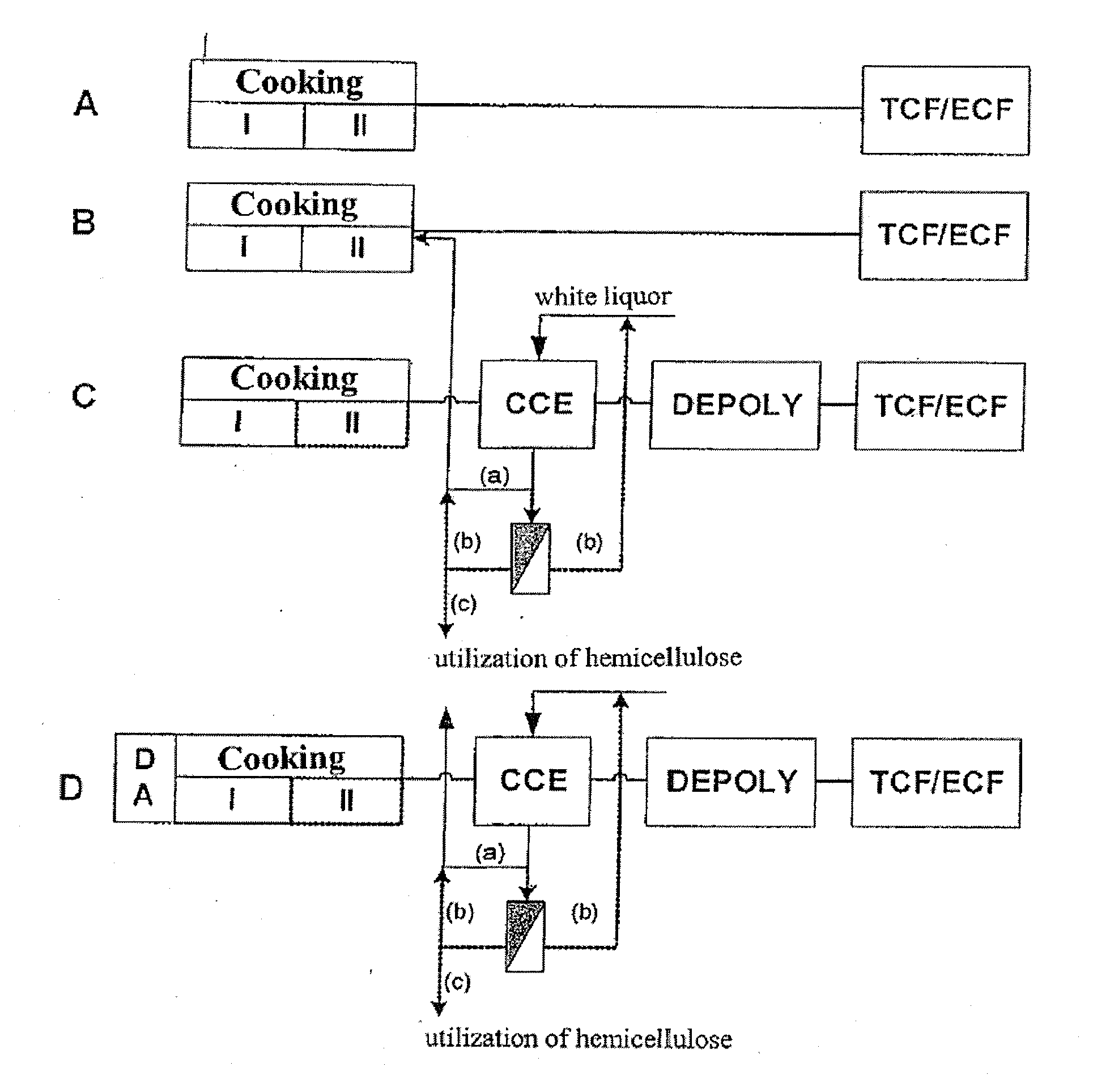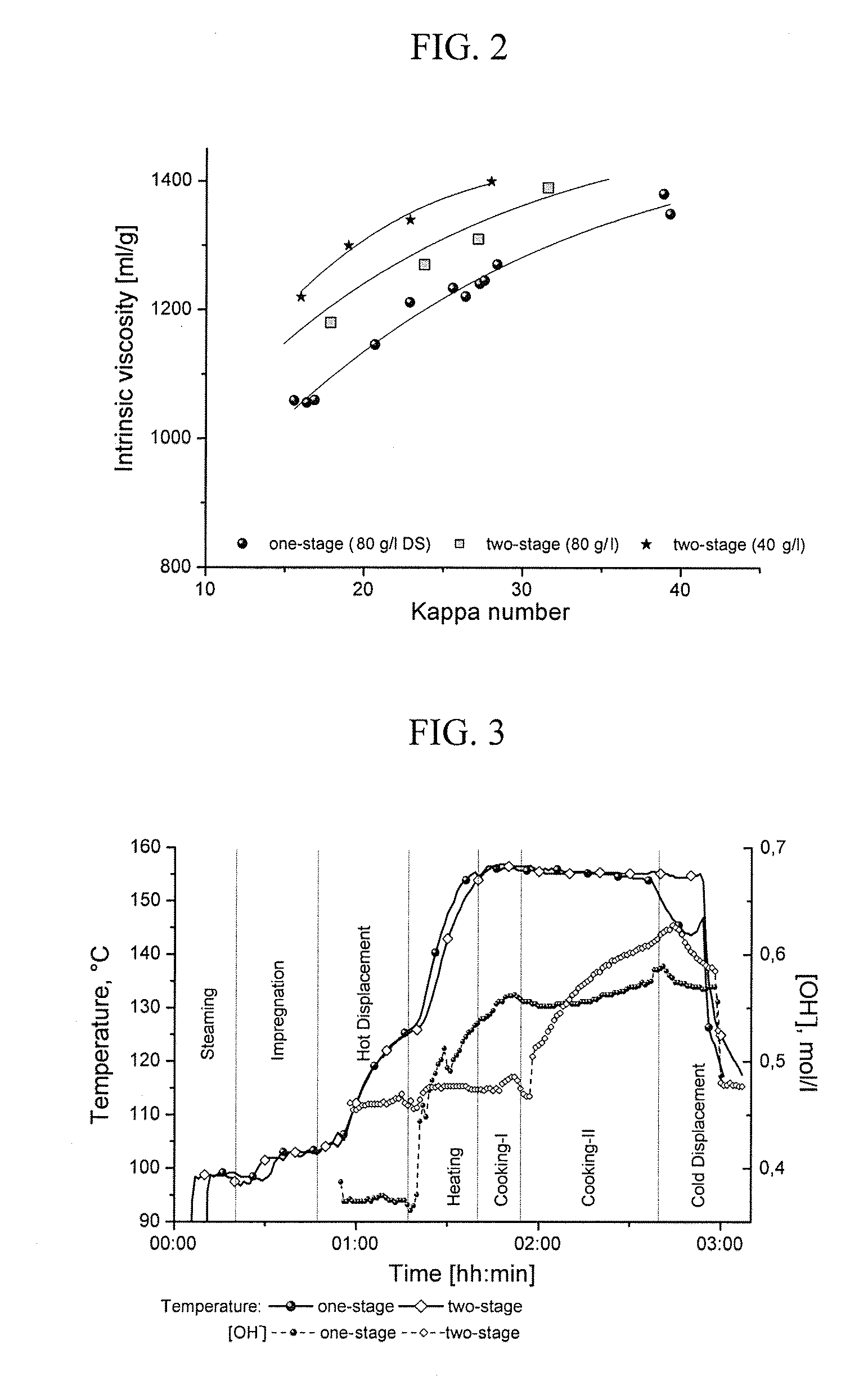Process For Producing A Pulp
- Summary
- Abstract
- Description
- Claims
- Application Information
AI Technical Summary
Benefits of technology
Problems solved by technology
Method used
Image
Examples
example 1
Two-Stage CBC Cooking of Whitewood
[0097]Whitewood is cooked to pulp with kappa numbers of between 16 and 42 in a test cooker of 10.8 l according to the CBC process (continuous batch cooking). The single-stage reference cooking has the following conditions:[0098]Impregnation: [OH—]=0.37 mol / l, [HS—]=0.22 mol / l; mean temperature 120° C., 30 min (filling direction from below to above)[0099]Heating: Displacement of the impregnating liquor by a preset cooking liquor (direction of displacement from above to below). After 28 minutes, the target temperature of 160° C. is reached.[0100]Cooking stage: Cooking liquor is pumped through the cooker from above to below at a flow rate of twice the cooker volume per hour: 160° C., [OH—]=0.62 mol / l, [HS—]=0.30 mol / l, H-factors: 800-1600.
[0101]Impregnation and heating of the two-stage CBC cooking according to the invention were carried out along the lines of the single-stage variant.[0102]Cooking stage 1: 160° C., [OH—]=0.48 mol / l, [HS—]=0.48 mol / l, H...
example 2
Two-Stage CBC Cooking of Eucalyptus globulus
[0110]Eucalyptus globulus is processed into pulp with kappa numbers of between 13 and 28 in a test cooker of 10.8 l according to the CBC process (continuous batch cooking).
[0111]The single-stage reference cooking (one-stage) has the following conditions:[0112]Impregnation: [OH—]=0.38 mol / l, [HS—]=0.25 mol / l; mean temperature 120° C., 30 min (filling direction from below to above)[0113]Heating: Displacement of the impregnating liquor by a preset cooking liquor (direction of displacement from above to below). After 30 minutes, the target temperature of 155° C. is reached.[0114]Cooking stage: Cooking liquor is pumped through the cooker from above to below at a flow rate of twice the cooker volume per hour: 155° C., [OH—]=0.65 mol / l, [HS—]=0.34 mol / l, H-factors: 200-500.
[0115]Impregnation and heating of the two-stage CBC cooking (two-stage) were carried out along the lines of the single-stage variant.[0116]Cooking stage 1: 155° C., [OH—]=0.46...
example 3
Production of High-Yield Dissolving Pulps for Further Processing into Viscose and Lyocell Fibres
[0123]Prior to the beginning of CBC cooking, the wood was exposed to steam activation (DA) by bringing the content of the cooker to a temperature of approx. 165° C. with the aid of medium-pressure steam. CBC cooking was carried out in a single stage.
[0124]For better identification, the combination of the processes DA+CBC is subsequently indicated by “CBC*”. After O-delignification, CBC* pulp was subjected to a cold caustic extraction with the aim of removing the hemicelluloses soluble in alkali. DP-adjustment was effected by ozone treatment (Z) within the scope of final bleaching. The subsequent P-bleaching served for the stabilization of the cellulose and for the adjustment of the desired final degree of whiteness. As a reference pulp, a prehydrolysis kraft pulp was produced by means of “VISCBC” technology (modified visbatch process, see Wizani, W., et al. “CBC—Continuous batch cooking. ...
PUM
| Property | Measurement | Unit |
|---|---|---|
| Temperature | aaaaa | aaaaa |
| Temperature | aaaaa | aaaaa |
| Fraction | aaaaa | aaaaa |
Abstract
Description
Claims
Application Information
 Login to View More
Login to View More - R&D
- Intellectual Property
- Life Sciences
- Materials
- Tech Scout
- Unparalleled Data Quality
- Higher Quality Content
- 60% Fewer Hallucinations
Browse by: Latest US Patents, China's latest patents, Technical Efficacy Thesaurus, Application Domain, Technology Topic, Popular Technical Reports.
© 2025 PatSnap. All rights reserved.Legal|Privacy policy|Modern Slavery Act Transparency Statement|Sitemap|About US| Contact US: help@patsnap.com



